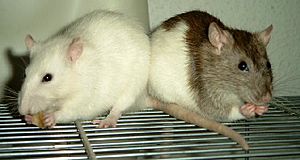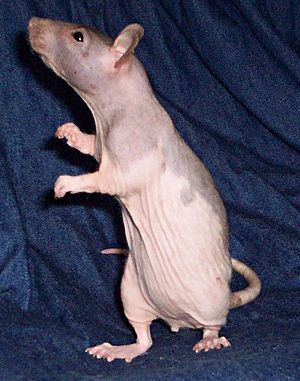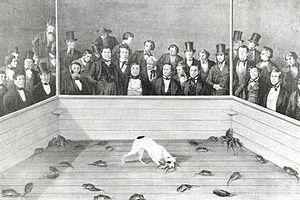Fancy rat facts for kids
Quick facts for kids Fancy ratTemporal range: Early Pleistocene - Recent
|
|
|---|---|
 |
|
| Conservation status | |
| Scientific classification | |
| Kingdom: | |
| Phylum: | |
| Class: | |
| Order: | |
| Suborder: | |
| Superfamily: | |
| Family: | |
| Subfamily: | |
| Genus: |
Rattus
Fischer de Waldheim, 1803
|
| Species | |
A fancy rat or pet rat is a type of brown rat (Rattus norvegicus) that people have bred to be a pet. The name fancy rat doesn't mean they look "fancy" or special. It comes from the phrase animal fancy, which means a hobby of breeding and showing animals.
People who keep pet rats are part of "rat fancy." While some people keep black rats (Rattus rattus) or Gambian pouched rats, these are not usually called fancy rats. The hobby mainly focuses on the brown rat type.
Fancy rats have been kept as pets since at least the late 19th century. They come in many different colors and coat types. They are sociable and very intelligent animals. They can learn to come when called, use a litter box, and do many tricks.
Pet rats act differently from rats found in nature. This is because they have been bred by humans for many generations. Fancy rats are not any more of a health risk than other common pets. They do not have the same diseases as wild rats. Fancy rats can have ears on the top of their head (standard) or on the side (dumbo).
Contents
History of Fancy Rats
The story of modern fancy rats starts with rat-catchers in the 18th and 19th centuries. These people caught rats all over Europe. They would either kill the rats or sell them for a sport called rat-baiting. In this sport, dogs would fight rats.
It is believed that rat-catchers and sportsmen started keeping rats with unusual colors. They would breed these special rats and then sell them as pets. Two important people in the early days of rat fancy were Jack Black and Jimmy Shaw. Jack Black was the rat-catcher for Queen Victoria. He was known for taming "prettier" rats with unique colors. He would even decorate them with ribbons and sell them as pets.
The hobby of keeping fancy rats became more organized when a woman named Mary Douglas got permission to show her pet rats. This happened at an exhibition of the National Mouse Club in England on October 24, 1901. Her black-and-white hooded rat won "Best in Show." This made many people interested in keeping rats as pets.
After Mary Douglas passed away in 1921, the hobby became less popular. It was part of the National Mouse and Rat Club from 1912 to 1929 or 1931. Then, "Rat" was removed from the club's name. The hobby was brought back in 1976 with the start of the English National Fancy Rat Society (NFRS). Today, pet rats are easy to find in stores and from breeders. There are many rat fancier groups around the world.
Fancy Rat Varieties
Just like with other pets, fancy rats have many different colors, coat types, and other features. These traits do not appear in wild rats. They have either been developed through breeding or appeared naturally. Each rat can be described by its color, coat, markings, and body type. For example, you might see a "ruby-eyed cinnamon Berkshire rex Dumbo" rat.
Coloring and Eye Color
Some pet rats have the agouti coloring, which is like the wild brown rat. This means each hair has three different tones. Other rats have solid colors, with each hair being a single color. Agouti-based colors include agouti, cinnamon, and fawn. Black-based colors include black, beige, and chocolate.
Eye color is also part of a rat's coloring. Many genes that control eye color also affect the coat color. The American Fancy Rat and Mouse Association (AFRMA) lists black, pink, ruby, and odd-eyed (two different-colored eyes) as possible eye colors. "Ruby" eyes look black at first glance, but they are a deep, dark red when you look closely.
Markings on Fancy Rats
Fancy rats also have many different markings. These are patterns and amounts of colored hair mixed with white hair. A self rat is completely one solid color with no white. A Himalayan rat is mostly white, but has colored areas on its nose and feet, called points. This is similar to a Himalayan cat's markings.
Markings have strict rules for showing in fancy rat pet shows. However, many pet rats are not bred to these exact rules. Many rats found in pet shops might have "mismarkings." These are variations in markings that are not officially recognized by rat fancier groups.
Common markings include:
- Berkshire – The rat has a colored top and a white belly.
- Hooded – The color forms a single, unbroken line from the head down the back and sometimes partly down the tail.
- Capped – The color is only on the rat's head.
- Blazed – The rat has a colored head or body with a triangular wedge of white fur over its face.
- Variegated – This means the fur has mismatched or odd patterns. It can be a broken or spotted hood, or a misshaped blaze.
- Irish or English Irish – In England, this marking is a white equilateral triangle on the chest, starting between the front legs. In the United States, an Irish rat can have white fur anywhere on its underside, as long as it's even and symmetrical.
Other markings include spotted or Dalmatian (like a Dalmatian dog), essex, masked, and Siamese (a color gradient that is darkest at the tail base and nose, like Siamese cats). There are also downunder rats, an Australian type with a solid color stripe or marking on their belly that matches markings on their back.
Body Types of Fancy Rats
Two main physical changes in fancy rats come from selective breeding: the Dumbo and the Manx. The Dumbo rat started in the United States. It has large, low, round ears on the sides of its head. It was named because it looks a bit like Dumbo the Elephant. The Manx rat has no tail. This is due to a genetic mutation. It was named after the Manx cat, which also has no tail.
Coat Types of Fancy Rats
There are fewer coat types compared to colors and markings. Not all coat types are recognized worldwide. The most common type is the normal or standard coat. Male rats have a coarse, thick, and rough coat, while females have softer and finer fur.
Other common coat types include:
- Rex – All the hairs are curly, even the whiskers.
- Velveteen – A softer version of the rex coat.
- Satin or silky – This coat is extra-soft and fine, with a shiny look.
- Harley – This coat has wispy, long, straight hairs.
Some coat types are defined by a lack of hair, like hairless rats.
Hairless Rats

Hairless rats are a coat type that have different amounts of hair loss. They were bred from curly-coated rex rats. Hairless rats can have areas of very short fur or be completely bare. They are created by breeding different combinations of genes that cause rex coats.
Since the rex trait is dominant, only one rex parent is needed to have curly-coated babies. However, if a rat gets two copies of the rex gene (by breeding two rex rats together), their coat is affected differently. This causes them to be hairless, and they are sometimes called "double-rex" rats. One type of semi-hairless rat, called Patchwork rats, constantly lose and regrow hair in different "patches" throughout their lives.
See also
In Spanish: Rata doméstica para niños






